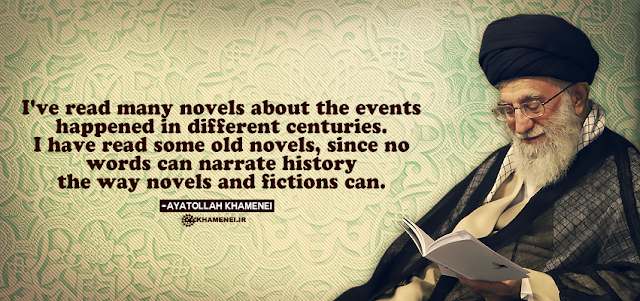هیچ
بیانی نمیتواند تاریخ را مثل داستان و رمان بیان كند. وقتی دربارهی
تاریخ به زبان غیر هنری حرف میزنیم، مثل این است كه از فاصلهی ده-هزار
پایی زمین، از شهری عكس برمیداریم. طبیعتاً ابعاد شهر و خیابانهای اصلی
شهر هم پیداست، اما در آنجا آدمها چه كار میكنند؟ خوبند؟ بدند؟ فقیرند؟
غنیاند؟ راحتاند؟ خوابند؟ دعوا میكنند؟ میرقصند؟ اصلاً هیچ چیزی معلوم نیست.
تاریخ از آن بالا، از ده هزار پایی، شهری را عكسبرداری میكند و به ما نشان میدهد. یك وقت هست شما وارد شهری می شوید، البته همهی كوچههای شهر را نمیتوانید ببینید، اما دو سه كوچهی شهر یا خیابان شهر را میروید. با افرادش حرف میزنید و از خانهها عكس برمیدارید؛ از اتاقها، از اسباببازی بچهها، از بوسیدن یك فرزند توسط مادرش ... همهی اینها را ترسم میكنید و در یك عكس جلوی ما میگذارید. البته یك كوچه است، یك خیابان است، همهی شهر نیست، اما میشود آن را تعمیم داد ... این زبان هنر از تاریخ است؛ قصه این است.
“No words can narrate history the way novels and fictions can. When we talk about history in a language other than an artistic one, it is like we take photos of a city from a thousand-foot distance. Naturally the dimensions and the main streets of the city can be seen but what are the people doing there? Are they good? Evil? Rich? Poor? Comfortable? Asleep? Are they fighting? Dancing? No such questions can be answered in that kind of narrative. The Historical narrative is from up there and can show photos of a city taken from a 10 thousand feet altitude. On the other hand, in an artistic narrative you can well imagine that you have got into a city. Naturally you cannot visit all the streets in there, but you walk through a couple of alleys and streets of the city, you talk to people and take photos of houses, rooms, kids’ toys, a mother kissing her baby, … and all that is being portrayed and shown to us in a single photo. Although all that was about a single alley or a single street out of an entire city, but you can generalize that picture… this is an artistic narrative of history which is called novel.”
تاریخ از آن بالا، از ده هزار پایی، شهری را عكسبرداری میكند و به ما نشان میدهد. یك وقت هست شما وارد شهری می شوید، البته همهی كوچههای شهر را نمیتوانید ببینید، اما دو سه كوچهی شهر یا خیابان شهر را میروید. با افرادش حرف میزنید و از خانهها عكس برمیدارید؛ از اتاقها، از اسباببازی بچهها، از بوسیدن یك فرزند توسط مادرش ... همهی اینها را ترسم میكنید و در یك عكس جلوی ما میگذارید. البته یك كوچه است، یك خیابان است، همهی شهر نیست، اما میشود آن را تعمیم داد ... این زبان هنر از تاریخ است؛ قصه این است.
“No words can narrate history the way novels and fictions can. When we talk about history in a language other than an artistic one, it is like we take photos of a city from a thousand-foot distance. Naturally the dimensions and the main streets of the city can be seen but what are the people doing there? Are they good? Evil? Rich? Poor? Comfortable? Asleep? Are they fighting? Dancing? No such questions can be answered in that kind of narrative. The Historical narrative is from up there and can show photos of a city taken from a 10 thousand feet altitude. On the other hand, in an artistic narrative you can well imagine that you have got into a city. Naturally you cannot visit all the streets in there, but you walk through a couple of alleys and streets of the city, you talk to people and take photos of houses, rooms, kids’ toys, a mother kissing her baby, … and all that is being portrayed and shown to us in a single photo. Although all that was about a single alley or a single street out of an entire city, but you can generalize that picture… this is an artistic narrative of history which is called novel.”

هیچ نظری موجود نیست:
ارسال یک نظر